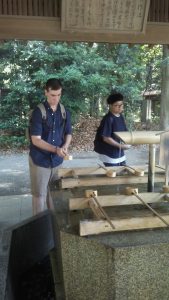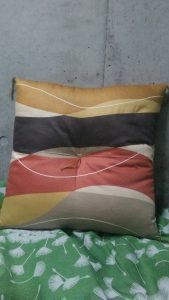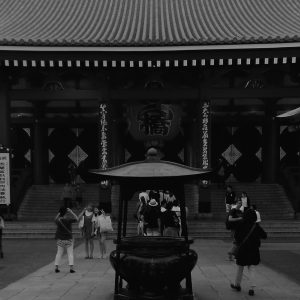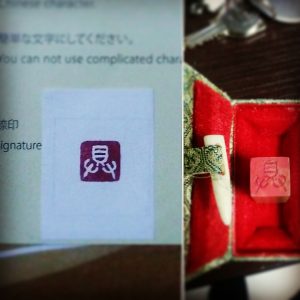Quinn Sipes
NOH Theatre
Tokyo, Japan
Summer 2017
It has been two days since my last blog post and already so much has happened! First off, I would like to say that the crazy and overwhelming city of Tokyo is now easier to navigate after I wised up. Now, before I leave, I look up the address of the places I want to go while I have Wi-Fi and then screenshot the map and the directions to get to that place. I also have decided to just let the whirlwind that is Tokyo, take me to where I need to go rather than try to control it and live by the idea that “it happens.”
Other good news is that some of my money has been deposited and I can’t convey to you just how happy I am! I was so worried that I would have to make about 100 dollars stretch for 3 weeks, which would more than likely be impossible in a city where one dish usually averages 10 USD. But, I have money now and I am eating more than one meal every two days, and my goodness the food here is so delicious!
One of the things that I was looking forward to the most, when I was preparing to go to Japan, was to visit Shinto and Buddhist Shrines and Temples. I had the privilege to visit a shrine relatively close to where I live. The shrine known as Meiji-Jingu is a Shinto shrine located in Yoyogi Park right in the center of Tokyo’s famous Harajuku. The shrine, encased by a huge park that drowns out the sounds of modern day Tokyo, makes anyone who visits feel like they are in a rural Japanese town. The towering skyscrapers around the area are replaced by huge trees, and the sound of Tokyo traffic is replaced with the sounds of the birds and crickets.

Enshrined in Meiji-Jingu is Emperor Meiji and Empress Shoken, Japan’s most revered royal family. When the Emperor died, the Japanese people built the shrine to honor him. The shrine burned down during World War II but was rebuilt by the Japanese people and the original shrine will turn 100 in 2020. When I visited, the copper plates on the roof were being refurbished and replaced for the centennial celebration and the Olympic games in 2020. I was also extremely privileged to witness a Shinto wedding procession into Meiji-Jingu. I sadly did not take any pictures, because I didn’t want to be irreverent to the couple getting married, and I wasn’t too sure about the policy on photographing Shinto wedding ceremonies.
The bride and groom were in beautiful traditional clothing and were being led in on a carriage. In the front of the procession seemed to be the head Shinto priest, followed by a drum, and then a few more priests (I think they were priests) who were chanting, and then the bride and groom came in on the carriage. It was very beautiful to witness and I wish I had been able to take a few stealthy photos.
Once I was in the shrine, I went and prayed for world peace and universal harmony. Through my prayer at the alter, and through my ema (a wooden plaque where you write your wish and prayers on) I prayed for myself and I received an omikuji, a small poem written by Emperor Meiji, which tells you about what to expect for the year and words of wisdom to be followed. The whole shrine was very beautiful, and the people there were extremely kind and welcoming to all foreigners and their religions. One Japanese woman was asking every person that finished praying at the alter what their current religion is; a few of the answers were Islamic, Jewish, Christian, Hindu, B’hai, and Buddhist. It is very beautiful and wonderful to see religions that have had bad blood with one another, come together and be peaceful toward one another, and wish and pray for the same thing. It just shows how we are all human and want the same thing; to be loved by one another and be peaceful toward each other.
I returned to my share house at about the middle of the day and relaxed a little bit before heading out to Shinjuku to register for a class the following day (today). Out in Shinjuku, there are a lot of very tall skyscrapers and shopping areas, which reminded me of Midtown Manhattan in the way that it is sensory overload almost the whole time. I found this one place called the robot restaurant, which costs about 8,000 (80.00USD) yen for one dinner. It seems that the robot restaurant is one big show, along with a dinner, and the people that I saw leaving the restaurant said it was worth the 8,000 yen for the show alone. So, I think when my class is over and if I have enough money saved up, before I leave, I will go and see what the robot restaurant is all about.
Today I went to Asakusa, about an hour away from where I live, to take part in traditional Japanese arts and crafts. The share house company that I am staying with while in Tokyo is known as Sakura House, and they put on events for their residents every month. This month one of the last events was making traditional crafts in the form of Zabuton and Hanko.

A zabuton is a traditional Japanese cushion, which has a trademark of being balanced in all four corners. You are able to tell the quality of the cushion by holding it by the thread in the center of the cushion, and seeing it hold steady and flat while being suspended in the air. Needless to say, mine was less than perfect. One of my corners was too heavy, and if you tried to pick it up by the center thread, it leans to one side. Building this zabuton was a lot of work too! I had to rip the cotton apart, lay each layer out, open each layer, rip some more, then feel for depressions, and add left over cotton to my cushion before I could even shape it into a cushion! Then came getting it into the cover, which is another long and drawn out process. In total, making one zabuton took me over 3 hours!

I had a little break between the two crafts so I went to Senso-Ji, a Buddhist temple in Asakusa, which is famous for how massive it is as well as the shopping street in front of it. I got lost there for a few hours and had some really, good fried chicken. It wasn’t like Granny B’s where it was fried with a breading, but rather just straight chicken fried in sesame oil. Some of the best fried chicken I have had in a while, actually. I explored the surrounding area of Senso-Ji until it was time to make a hanko.
A Japanese hanko is a traditional name stamp used by the Japanese to sign their name on contracts and loans from the bank. Every person in Japan has a hanko and uses it for official documents. The process started with us writing our names and then having someone write out a few modern Japanese characters, which mimic the sounds of our name. My name, being hard for them to wrap their minds around, because Quinn doesn’t exist in their language, ended up being a square. As I waited for them to explain how to make the hanko, I stared at my character, extremely upset that my stamp will just be a square. I felt terrible and like it was a waste of time at this point. Then something amazing happened! One of the professionals came around with a book of ancient Japanese characters, saw our modern day characters and then translated them to the ancient characters that they came from.

My little square “gu” turned into this face with two outstretched opened hands. I asked the professional why we were using the ancient characters, she said the ancient characters are more symmetrical and can be given meaning to them more so than some of the modern day characters. I then asked what my character meant now, and she said that it means giver or offering to the gods. I was thrilled and to be perfectly honest, the character looks really cool! After she wrote the character onto our stamp, we took an engraving tool and etched our character into the stone. It was rough work to do it by hand, but it was extremely relaxing for some reason. My stamp turned out to look pretty good, and the professional didn’t have to do too much in order to fix it. After I finished making my hanko, I stopped for dinner at this little place known as McDonalds. I know, I know, hate on me as much as you want for eating McDonald’s in a foreign country. However, I had only 500 yen that I was willing to spend and I didn’t want to go looking for a place that was selling traditional Japanese food at 500 yen…so I ate at McDonalds. I will say that it is a lot better than American McDonalds. Here in Japan, when you order something off the menu, the item actually looks like the picture on the menu compared to when you order something and it looks like it was run over by a truck.
That pretty much concludes my past two days here, and tomorrow I start my class in Noh theatre. I can’t wait to meet everyone in my class! I know this class is about to be super intensive, but I am ready for it. The only thing I may have a problem with is sitting sezah for long periods of time.